Greek Vase Painting
Ancient Greek art was an important part of the lives of the people.
Vase painting was important, and the pots would normally feature paintings of people or figures.
Vases were part of a way that the Ancient Greeks made money and artists would sell and trade vases to make a living.
Greek vase painting was a popular art form in ancient Greece, with many vases being decorated with intricate designs and scenes from mythology. These vases were often used for practical purposes, such as storing wine or oil, but also served as a way to showcase the artistic skill of the painter.
The use of black and red figures on the vases allowed for a greater level of detail and realism in the depictions, and many of these vases have survived to this day, providing valuable insights into ancient Greek culture and art.
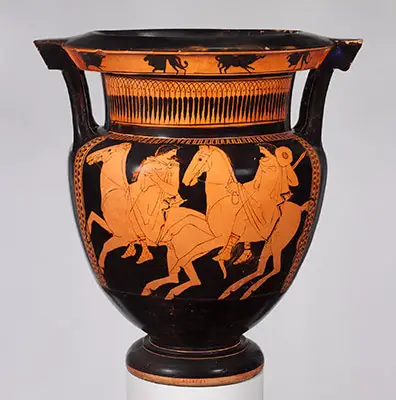
Greek Vase Painting Facts
- Greek Vase Painting dates back to the Bronze Age.
- The earliest style was the Geometric style.
- Black-figure technique was popular in the 6th century BC.
- Red-figure technique started around the late 6th century BC.
- Vase paintings often depict myths and daily life.
- Vases were used for storage, rituals, and even as prizes.
- Exekias and the Berlin Painter were famous vase painters.
- Amphorae and kraters were common vase shapes.
- Hellenistic Art introduced more detailed vase painting.
- Conservation helps preserve these ancient artworks for future generations.
Vase Painting
The most popular vase painting was when the Ancient Greeks would paint a red or a black pot. These vases were used mostly for holding wine and for holding water.
The vases were popular in homes, especially the homes of wealthy people. They were considered pieces of artwork and were also practical because they held important things.
Shapes
The shape of the vase was different during different times in Ancient Greece. Some of the vases would be made as different sections.
There would be a foot, a neck, and handles. The sections were joined together and would be dried. Each vase was unique and had a unique shape and a unique size.
The vases might be small, or they might be large. Depending on what the vase was going to hold, the artist would decide what shape it was going to be.
The most common was wine holders and it was called a krater and it was used to mix the water into the wine.
A vase for pouring the wine would be called a oinochoai. The cups that had stems were also considered vases and they were called kylixes. To hold oil or perfume, the vase maker would make a lekythoi jar.
They were sturdy and had handles so that they could be carried easily. Each one would then be decorated to the buyer or artists choice.
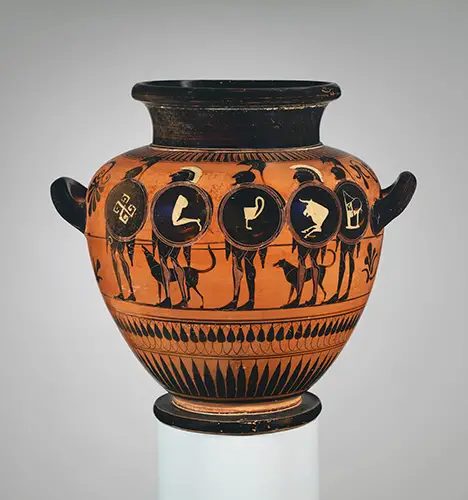
Pottery
The vases were made on a pottery wheel and they were made out of clay. The handles and other shapes would be added with clay slip.
This would allow the parts to stick together and then the pot would dry.
Painting
The vase would then be decorated, and it would depend on the time as to what style was used.
The vase would be painted with black or other colored paint and the marks would be put on the vase with a small brush. The brush would be made out of feathers or animal tail.
When a vase was painted, the painter would put on multiple layers of paint and the paint would eventually chip off.
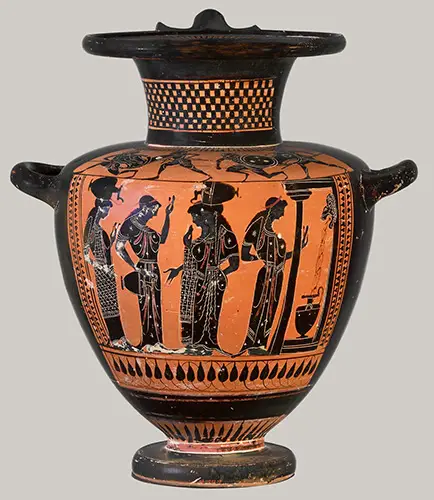
Firing
The vase would have to be put into a fire so that it would harden and last for a long time.
The pottery was considered softer than modern pottery and that is because of the lack of heat the vase would be put in.
Painter
The painter of the vases usually was considered an artist, or a specialist and they would paint the vases and sell them to make a living.
Each painter had their own style and design and people could tell if a certain artist painted a vase.
Painters painted vases in workshops and was usually considered a master potter.
The artists did not have any type of government control over them and they were allowed to paint whatever they wanted on the vase.
Most of the workers were paid the same as manual laborers or crafters and it would usually only cost the buyer a day wage to purchase a vase.
Some artists made over 200 vases.

Ancient Greek Pottery
Ancient Greek Pottery is closely linked to Greek Vase Painting. The pottery from this period served as a ‘canvas’ for artists to portray various subjects, including myths, legends, and scenes from daily life. These narratives offer important insights into the ancient Greek culture and religion.
The shapes of the pottery items, such as amphorae and kraters, were often chosen to complement the painted scenes. The form and function of the pottery influenced the content of the painting, and vice versa. This reflects the artistic synergy in Ancient Greek society and the importance of pottery in Greek Vase Painting.
Ancient Greek Art
Greek Vase Painting is a key part of Ancient Greek Art. The Greeks, known for their sculptures and architecture, also used pottery as a canvas for artistic expression. Unlike grand sculptures and buildings, vase paintings often showed intimate aspects of Greek life, including mythology, history, and everyday scenes.
Therefore, Greek Vase Painting plays a significant role in Ancient Greek Art, offering a closer look into the personal and social dimensions of ancient Greek society that is not always evident in the more monumental works.
Black-figure technique
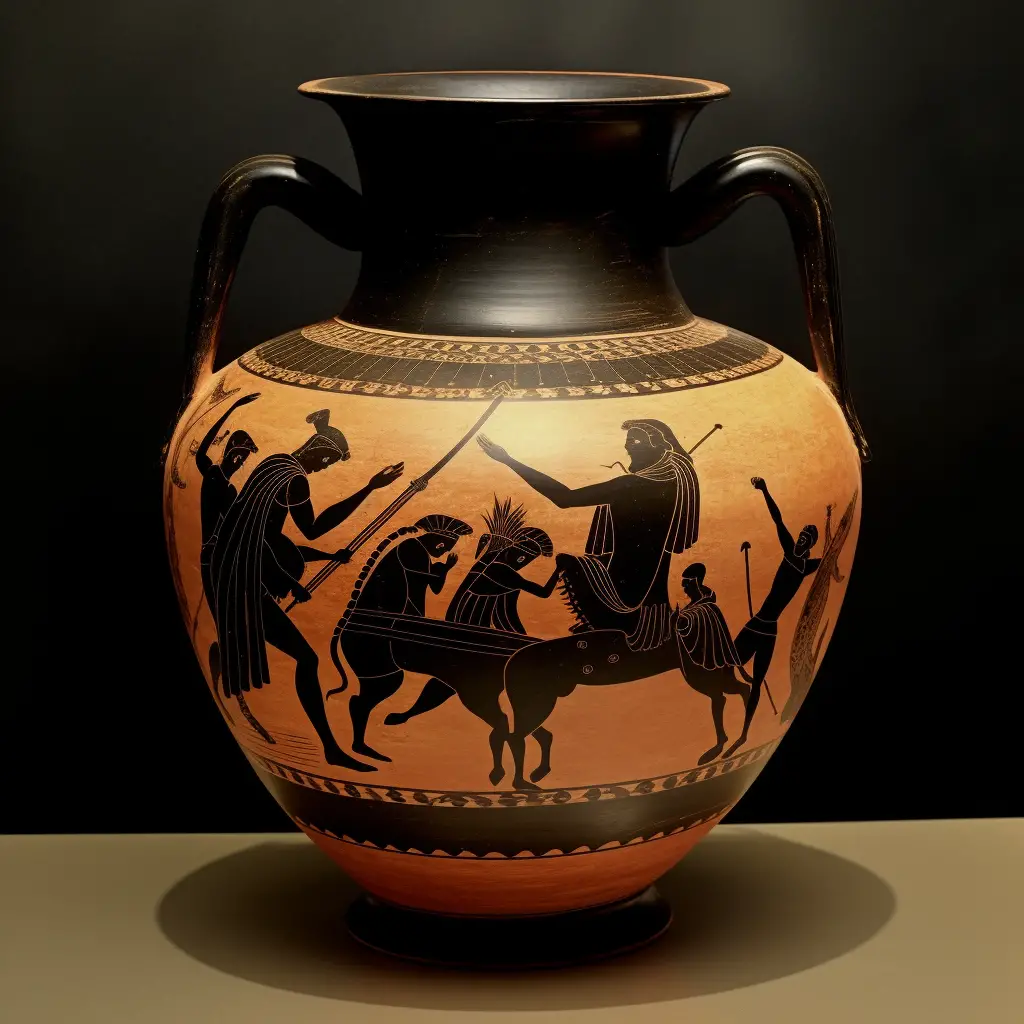
The Black-figure technique is a key part of Greek Vase Painting. It originated in Corinth in the 7th century BC and involved painting figures in black against the clay’s natural red color. Artists would carve details into the black figures, revealing the red beneath them.
This technique was used to depict scenes from mythology, battles, and daily life. Despite the later popularity of the Red-figure technique, Black-figure painting remained a commonly used and impactful method in Greek Vase Painting.
Red-figure technique
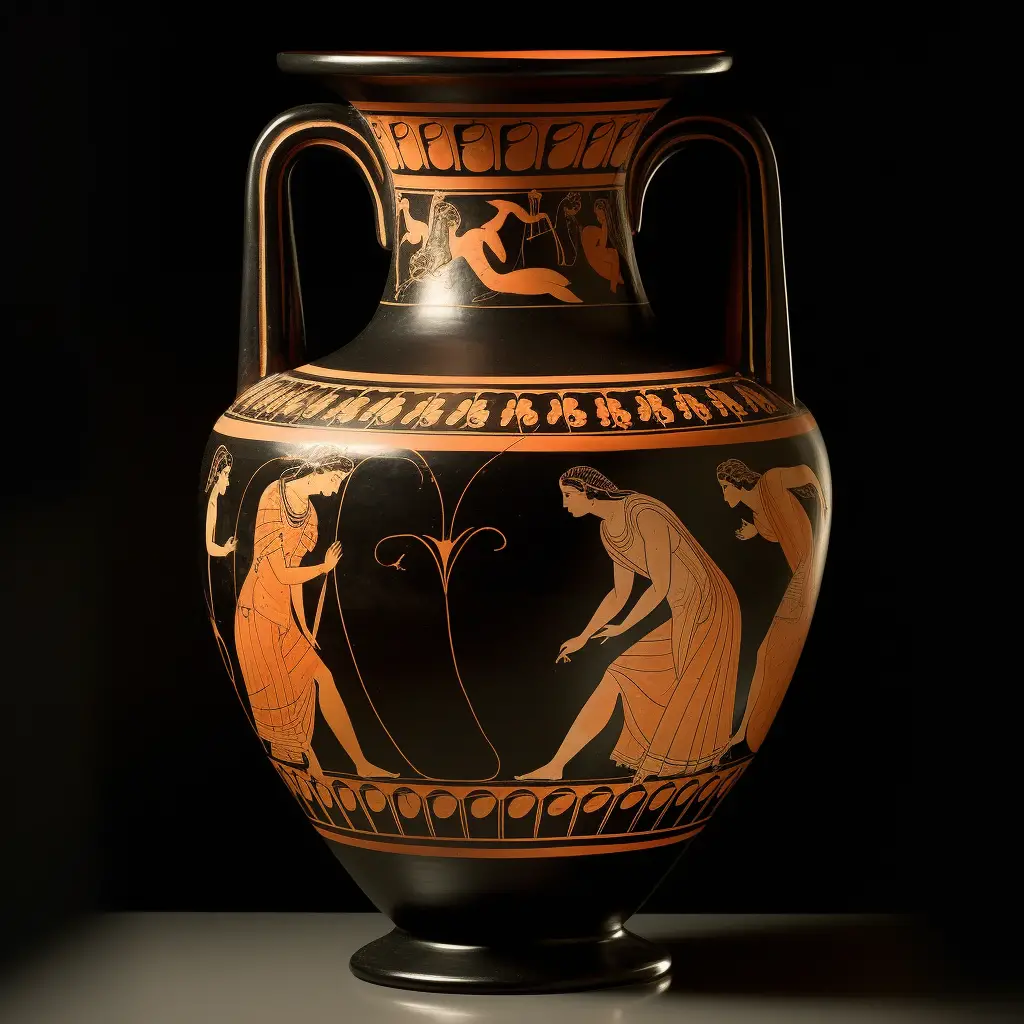
The Red-figure technique is a significant aspect of Greek Vase Painting. It started in Athens in the late 6th century BC and reversed the color scheme of the earlier Black-figure style. Figures were kept in the natural red color of the clay, while backgrounds were painted black.
This allowed for detailed and realistic depictions, often including scenes from mythology, sports, and social events. The Red-figure technique influenced Greek Vase Painting until the late classical period, marking an important period in Greek art history.
Mythology in Ancient Greek Art
Mythology is a key theme in Ancient Greek Art, including Greek Vase Painting. Mythological stories of gods and heroes provided ample inspiration for artists, reflecting not only religious beliefs but also societal norms. Vases depicting these tales were both practical items and tools for cultural storytelling. They often illustrated well-known epic narratives like the labors of Heracles or the Trojan War.
As painting styles evolved, so too did these depictions. Therefore, Greek Vase Painting is an important component of Ancient Greek Art, linking art, religion, and storytelling through its vibrant representation of mythology.
Athenian Potters and Painters
Athenian Potters and Painters played a major role in Greek Vase Painting. In the 6th and 5th centuries BC, they significantly contributed to the development of both black-figure and red-figure pottery styles. Artists like Exekias combined craftsmanship and storytelling in their work.
Some painters, like the Berlin Painter, developed unique styles, and their work depicted myths, historical events, and daily life. Thus, Athenian Potters and Painters greatly influenced Greek Vase Painting, shaping this notable art form with their creativity and skills.
Greek Vase Shapes and Uses
Greek Vase Shapes and Uses greatly influenced Greek Vase Painting. The form and purpose of a vase often determined what scenes would be painted on it. For instance, amphorae, used for storing and transporting goods, often depicted athletics or Dionysian scenes.
Kraters, used for mixing wine and water, typically showed scenes of banquets. Smaller vessels like lekythoi, used for oil storage, might show domestic or funerary scenes. The shape of the vase also affected whether the black-figure or red-figure painting technique was used.
Thus, the forms and uses of Greek vases played a significant role in the artistic style and narrative content of Greek Vase Painting.
Hellenistic Art
Hellenistic Art, spanning from 323 BC to 31 BC, introduced significant changes in Greek Vase Painting. Unlike the earlier focus on red-figure and black-figure techniques, Hellenistic artists used more diverse styles, including multi-colored decorations and a greater emphasis on detail and naturalism.
The vases featured complex perspectives and emotional expressiveness. Subjects became more varied, featuring domestic scenes, theater, and mythology with increased realism. Therefore, Hellenistic Art marked a new phase of innovation in Greek Vase Painting, reflecting the broader cultural changes of the era.
The Role of Vases in Greek Rituals and Society
Vases played a key role in Greek rituals and society, which is evident in Greek Vase Paintings. These vases were functional and often used in social and religious activities. For example, larger vessels like kraters and amphorae were used in symposia (drinking parties), often depicting scenes from these events.
Lekythoi, smaller oil flasks, were used in funerary rites, featuring images related to death and the afterlife. Vases were also prizes in athletic competitions and offerings at religious sanctuaries. Therefore, the depiction of these activities on vases offers important insights into ancient Greek culture, highlighting the significance of vases in Greek rituals and society.
Conservation and Display of Ancient Greek Vases
The conservation and display of Ancient Greek Vases are vital for appreciating Greek Vase Painting. These vases require expert care, including restoration of broken pieces, stabilization, and careful cleaning to preserve the paintings.
When displayed in museums, they are usually kept under controlled lighting to avoid damage. Descriptions and context provided help interpret the scenes and understand their cultural importance. Therefore, the practices of conservation and display ensure the survival and appreciation of Greek Vase Painting for future generations.
More Fun Facts About Ancient Greek Vase Painting:
- Vases were mostly made and painted in Sparta, Crete and Cyprus.
- Some of the popular paintings on vases were circles or geometric shapes.
- Some vases were covered in triangles.
- Many artists painted human figures, animals such as birds and cows or other figures.
- At one-point, black figures were painted on vases and was a very popular vase painting.
- Red figures replaced the black figures and the figures were outlined with black.
What Did You Learn?
- What was the purpose of vases in Ancient Greek times? Vases were important to hold things and they were a way for artists to make a living.
- What shapes were the vases made in? Vases were made in shapes depending on what was going to go into the vase.
- What kinds of paintings were on the vases? The vases had paintings of animals, figures, black figures, red figures, triangles, circles and other geometric shapes.
- What were the restrictions artists had when painting vases? The artists had no restrictions when painting the vases.
- Why are Ancient Greek vases considered soft? Ancient Greek vases are considered soft compared to vases today because they did not have a way to fire the pottery to the right degree to get it hard.



